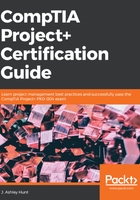
Understanding organizational structures
Much of your day-to-day lives running projects will be significantly impacted by your organizational processes and the culture of your organization. That could be based on your industry, what regulatory compliance is necessary, or simply because of how your organization chooses to run things.
The biggest impact on how these processes evolve is based mostly on how your organization is structured. Some structures are better than others for projects and sometimes trying to implement new best practices can be a bit painful due to your organizational influences.
I often look at organizational processes as the handbook of how they do things at an organization. The rules, best practices, and set processes. The enterprise environment is when you go to lunch with someone and they tell you how it really is! The organizational culture, the software you use, how assigning your resources works, and the political system within your organization are good examples of an enterprise environmental influence. In a perfect world, both the organizational processes and the enterprise environment need to work in harmony to get anything done. However, in general, harmony is the last thing that is occurring.
In order to get closer to the perfect world, it may be necessary to restructure the organizational dynamics to accommodate projects. Some organizations began as a siloed functional organization and then expand and grow into something more effective in the project-management space. This takes time and effort though, which is why many organizations avoid change. Change is painful and let's face it, change doesn't always work.
In my experience, when organizations attempt to massively change their structure to something more conducive to their current business needs, the entire organization goes from status quo to chaos. Unfortunately, organizations often blame the new set of processes as not working instead of understanding that change causes chaos and it takes time to reach the new normal. As a project management consultant, I've seen organizations try too many new things at once and put their staff into a tailspin. I always recommend they try a few new things until they are proficient, and then add new skills as needed. There is still chaos, but it is minimized.
You might be asking yourself, Where are these magical organizations that try new things to improve best practices? Trust me, I get it. Lots of organizations are like a squeaky wheel that never gets fixed; they are so set in their organizational processes that change isn't an option. So, what is a project manager to do?
Without proof something works, the wheel will always squeak. That is why it is so awesome that you are learning this information and preparing for your exams. Once you begin trying new best practices to improve your projects and you can see it is working, you now have the proof to back it up, and the respect that comes from your position and your certification.
Change is painful and chaotic, and we have enough going on every day, so I give you the same advice I give my clients. Outside of exam preparation (because you'll need to know all the information), try one to three new best practices you learn in this guide on your next project. If it doesn't work out so well, try again in a different way that better matches your system in the real world. Before you know it, you'll have the proof you need to show your organization the value of doing things a bit differently. Trust me if it saves them time or money or improves the quality of the result, they will listen and change will come.
One more thing to consider is how your organization is structured. Different structures and dynamics can help, or they can make your lives more challenging as IT project managers or as project managers in any industry. Once you know your structure, you can adapt the implementation of best practices accordingly. Some structures are designed for project management and may be more open to better best practices, and some are more focused on departmental operations and may be less enthused about changes.
Let's review the descriptions of each organizational structure, and as you go through, try to identify the one you are currently working in.